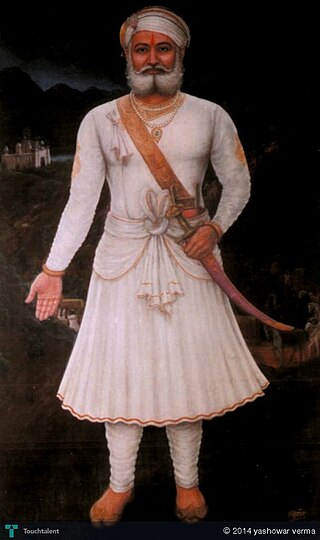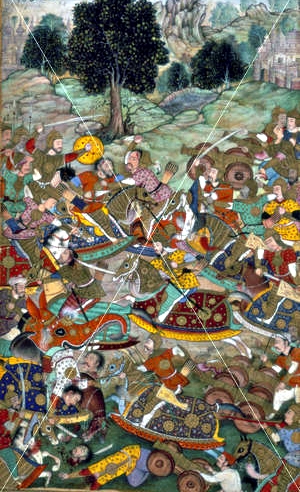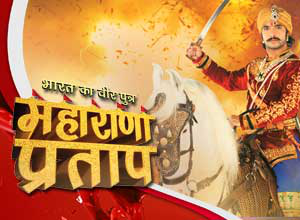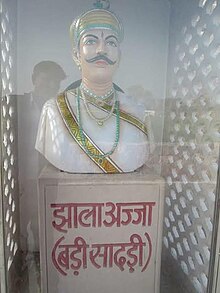
Sangram Singh I, commonly known as Rana Sanga, was the Rana of Mewar from 1508 to 1528 CE. A member of the Sisodia dynasty, he controlled parts of present-day Rajasthan, Gujarat and Madhya Pradesh with his capital at Chittor. His reign was admired by several of his contemporaries, including the first Mughal Emperor Babur, who described him as the "greatest Indian ruler" of that time. The Mughal historian Abd al-Qadir Badayuni called Sanga the bravest of all Rajputs along with Prithviraj Chauhan also known as Rai Pithaura.
The Sisodia was an Indian royal dynasty belonging to the clan that ruled over the Kingdom of Mewar, in the region of Mewar in Rajasthan. The name of the clan is also transliterated as Sesodia, Shishodia, Sishodia, Shishodya, Sisodya, Sisodiya, Sisodia.

Bhama Shah (1547–1600) was a noted general, minister and close aide of Maharana Pratap Singh. The financial support provided by him allowed Maharana Pratap to restore his army and reclaim much of his lost territory.

The battle of Haldighati was fought on 18 June 1576 between the Mewar forces led by Maharana Pratap, and the Mughal forces led by Man Singh I of Amber. The Mughals emerged victorious after inflicting significant casualties on Mewari forces, though they failed to capture Pratap, who reluctantly retreated persuaded by his fellow commanders.
Bari Sadri is a town and a municipality in Chittaurgarh district in the state of Rajasthan, India. It was a Feudal state ruled by Rajputs of Jhala clan till 1949.

The Kingdom of Mewar was an independent kingdom that existed in the Rajputana region of the Indian subcontinent and later became a major power in medieval India. The kingdom was initially founded and ruled by the Guhila dynasty followed by the Sisodiya Dynasty. The kingdom came to be known as the Udaipur State after it became a princely state in the nineteenth century.
Devi Garh Palace is a heritage hotel and resort, housed in the 18th-century Devi Garh palace in the village of Delwara. It was the royal residence of the rulers of Delwara principality, from the mid-18th century till the mid-20th century. Situated in the Aravalli hills, 28 km northeast of Udaipur, Rajasthan, Devigarh forms one of the three main passes into the valley of Udaipur.

Raimal Singh, also known as Rana Raimal, was a Hindu Rajput ruler of Mewar. Maharana Raimal was the son of Rana Kumbha and his Gaur queen, a princess of Ajmer.

The siege of Chittorgarh was the military expedition of the Mughal Empire under Akbar against the Mewar kingdom that commenced in 1567 during which the Mughals successfully captured the fort of Chittorgarh after a hard-pressed siege which lasted for several months.

The Mughal–Rajput wars were a series of battles between the Rajput Confederacy and the Mughal Empire. The conflicts originated with the invasion of northwestern India by the Mughal ruler Babur, to which the head of the Rajput confederacy, Rana Sanga, offered staunch resistance. The conflicts went on since 1526 for over 200 years, with the Mughals having the upper hand until the death of Aurangzeb in 1707, following which they entered a declining phase and the Rajputs gained the upper hand, with the last recorded conflict taking place in 1779.

Maharana Pratap: The First Freedom Fighter is an Indian epic film based on Maharana Pratap of Mewar .The film is directed and produced by Dr. Pradeep Kumawat from Udaipur, Rajasthan. It is the first time that a film has been made on the history of Maharana Pratap. The film's sound track includes one of the last songs sung by Late Jagjit Singh.

Bharat Ka Veer Putra – Maharana Pratap is an Indian historical fiction series produced by Contiloe Entertainment. It is based on the life of Maharana Pratap, a sixteenth century ruler of Mewar kingdom. It starred Sharad Malhotra, Rachana Parulkar, Faisal Khan and Roshni Walia.
Shakti Singh Sisodia Mewar was the son of Maharana Udai Singh II Sisodia and Rani Sajja Bai Solanki. He was a Kshatriya Rajput and was younger brother of famous Maharana Pratap, He was also the eponymous founder of the Shaktawat clan of Sisodia Rajputs.
Delwara, nestled in the Aravalli Range hills, is a small town about 28 km away from Udaipur, Mewar, and close to Eklingji Temple, on the way to the temple town of Nathdwara, in the state of Rajasthan, India. Delwara was originally known as ‘Devkul Patan Nagri’, which means the town of god. It boasted over 1500 temples at one time, out of which there were over 400 Jain temples. Delwara was the center of learning and culture before the 15th century AD. Around the middle of the 13th century, Raja Sagar, a Deora Chauhan and a descendant of Rao Kirtipal of Jalore, was a very brave king of Delwara (Mewar). Descendants of Raja Sagar sacrificed their lives while fighting alongside Ranas of Mewar against Muslim invaders. Raja Sagar was the progenitor of Bachhawat and Bothra clans of Oswals. Sagar's son, Kunwar Bohitya was immensely influenced and inspired by Jain philosophy. Samdhar, a grandson of Bohitya and a Deora Chauhan, was the first man in his genealogy to convert to Jainism.
Prithviraj Sisodia, generally known as Kunwar Prithviraj, was the eldest son of Maharana Raimal of Mewar and heir apparent of Mewar, of the Sisodia Rajputs. His mother was Jhali Rani Ratan Kanwar. His rapidity of moving from one place to another and lightning speed of attack earned him the title of Udno Prithviraj, the flying Prithviraj. He added the regions of Godwar and Ajmer to the territory of Mewar.
Haridas Kesaria or Haridas Mahiyaria was a 16th-century Mewar chieftain, warrior and poet from Rajasthan. In the Battle of Gagron in 1519, he fought alongside the Mewar army led by Rana Sanga, capturing and imprisoning the Sultan Mahmud Khalji II of Malwa, thus quickly ending the war. He was a close friend of Rana Sanga, participating in many battles and campaigns of Mewar kingdom. He fought as a commander in many battles including Battle of Khatoli, Battle of Gagron, Battle of Dholpur, Rana Sanga's invasion of Gujarat, Battle of Bayana and Battle of Khanwa in which he sacrificed his life on the battlefield while defending Rana Sanga.

Shahbaz Khan's invasions of Mewar were expeditions into Mewar by the Mughal forces of Shahbaz Khan Kamboh. The expansion of the Mughal Empire was initiated during the reign of Akbar the Great. This was notably evident in the Battle of Haldighati, where the Mewar forces suffered a futile defeat, compelling Rana Pratap to retreat to the hills. In the aftermath, multiple expeditions were dispatched to Mewar under the leadership of Shahbaz Khan Kamboh, ultimately leading to the permanent pacification of important territories like Mandalgarh, Kumbhalgarh, Gogunda, and Chittorgarh. These successful conquests culminated in the assimilation of Mewar into the Mughal Empire in 1616.
Deora or Devda, Devra is a clan of Rajputs. The Deora dynasty historically ruled over Bhinmal, Sirohi and Chandravati, India. Rao Deoraj was the progenitor of the Deora clan.

The Jhala also called Makwana and Makhwan is a Rajput clan, mentioned among the 36 royal races in the Kumarapala-prabandha list that ruled over Jhalavad region of Gujarat and parts of Rajasthan. Harpal Dev Makwana was the founder of Jhala clan.













